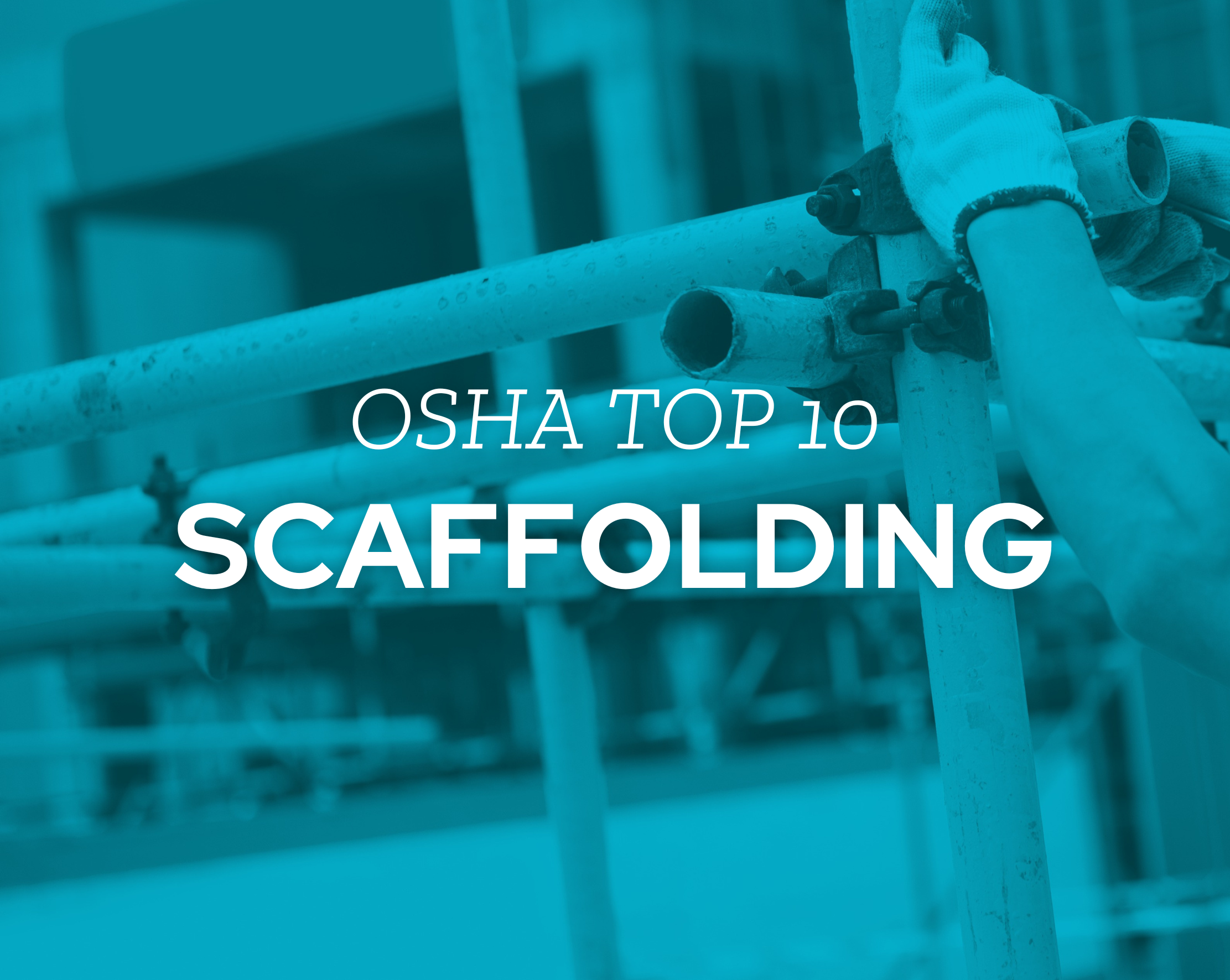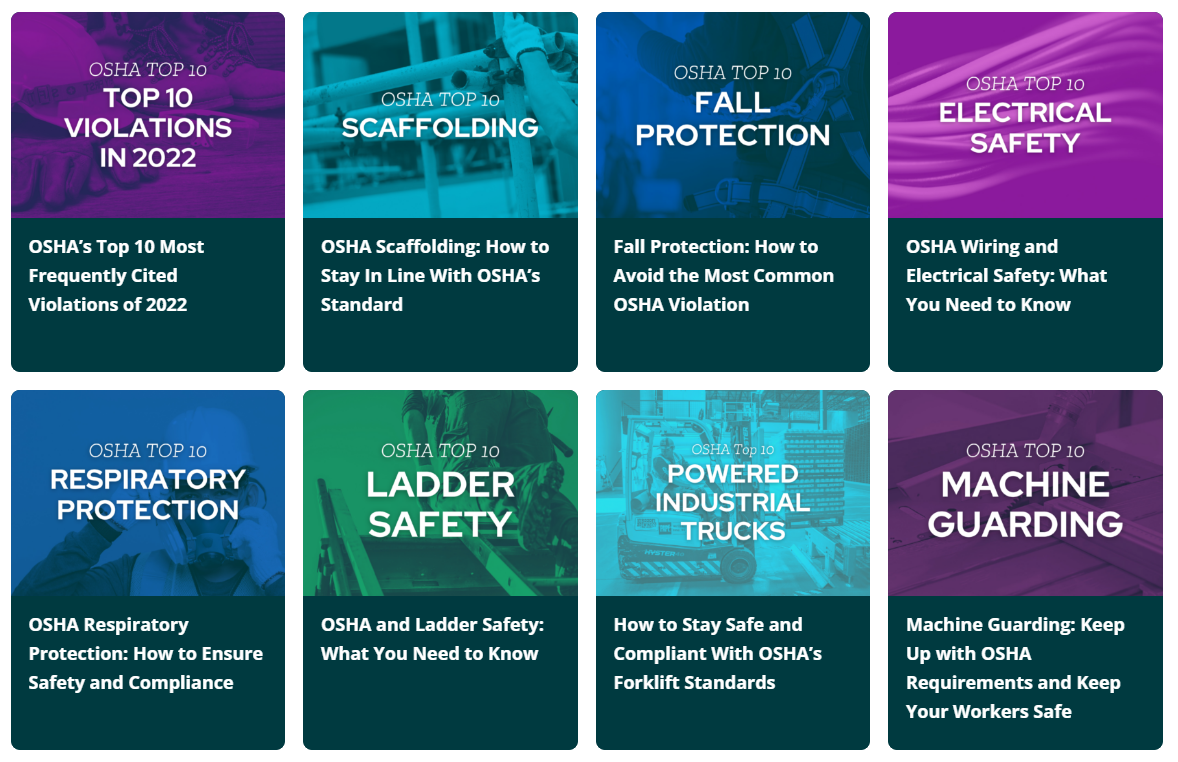OSHA Scaffolding: How to Stay In Line With OSHA’s Standard
Do you know everything you need to know about the 10 most frequently cited Occupational Safety and Health Administration standards? In this series, we’re exploring the most common OSHA violations, one by one. Keep reading to learn about OSHA’s scaffolding standards.
OSHA Scaffolding Standard: What It Is
OSHA definition:
OSHA’s scaffolding rules “[aim] to protect workers using scaffolding in construction work. Scaffolding hazards continue to rank high on the list of the most frequently cited standards in the construction industry. Scaffold-related fatalities account for a significant number of fatalities in the construction workplace.” (Source)
Simple definition:
A scaffold is a temporary structure that allows people to work in areas that are high off the ground or otherwise inaccessible. OSHA’s scaffolding standards lay out safe and proper methods for scaffolding used in construction jobs.
What is Scaffolding?
There are three types of scaffolds commonly used:
- Supported scaffolds consist of one or more platforms held up by rigid structural elements such as beams, brackets, poles, legs, or frames.
- Suspended scaffolds are platforms raised by non-rigid means, such as ropes or cables.
- Aerial lifts are elevating devices mounted to vehicles. Examples include extendable boom platforms, aerial ladders, and vertical towers.
OSHA’s scaffolding standard covers each of these kinds of scaffolds, as well as ladders, stilts, protection from falling objects, weather conditions, and other related hazards. The standard is extensive and detailed, specifying everything from fall protection measures to guardrail height to inspections and training.
Why Scaffolding Violations Happen
Scaffolding violations are common because scaffolds are standard construction equipment. The majority (65%) of construction projects involve scaffolds, according to the Bureau of Labor Statistics. Millions of construction workers across the US work on scaffolds every year.
The BLS estimates that 3 issues account for over 70% of all scaffolding accidents:
- Planking giving way when equipment is defective, damaged, poorly maintained, or incorrectly assembled
- Slips and trips due to slippery surfaces, missing protective measures (such as guardrails), and/or inadequate training
- Falling objects
Overall, most scaffolding violations are the result of faulty equipment, dangerous environmental conditions, improper training, or a combination thereof.
Read up on all of the top violations in the
OSHA Top 10 Resource Hub
What You Stand to Lose When Scaffolding Violations Happen
Direct costs: OSHA penalties can exceed $15,000 per violation—and as much per day for every day the issue hasn’t been fixed by OSHA’s deadline. The fine for a willful or repeated violation can be 10 times as much.
- workers’ compensation claims from workers injured by falls or falling objects
- lost productivity during and after an incident
- costs of replacing any damaged scaffolds or equipment
- legal and compliance fees
- decreased morale
- negative publicity and reputational damage
Signs You’re at Risk of a Fall Protection or Training Violation
Scaffolds are commonplace in the construction industry. Every time a worker needs to be elevated, there’s risk involved.
As discussed above, faulty and badly-maintained equipment is a leading cause of scaffolding accidents.
Any object resting on or above a scaffold can fall and become deadly.
Scaffolding is riskier during storms and periods of high wind, as well as immediately after rain or snowfall. Precipitation creates slippery surfaces, increasing the danger of slips and falls.
Every worker who works on a scaffold needs to be able to demonstrate knowledge of safe conduct.
OSHA specifies that a “competent person” must be on hand to a) determine whether scaffolds are safe to use, b) direct others in erecting and dismantling scaffolds, and c) conduct training and inspections.
How to Avoid a Scaffolding Violation: Your Prevention Checklist
Each employee more than 10 feet above a lower level must be protected from falls by guardrails or a fall arrest system, except those on single-point and two-point adjustable suspension scaffolds. Keep in mind that 10 feet only applies when the employee is working on a scaffold. If a scaffold is not involved and the employee is subjected to a fall hazard of 6 feet or more to a lower level, then a form of fall protection is required for that hazard. Each employee on a single-point and two-point adjustable suspended scaffold needs to be protected by both a personal fall arrest system and a guardrail.
The height of the toprail for scaffolds manufactured and placed in service after January 1, 2000 must be between 38 inches (0.9 meters) and 45 inches (1.2 meters). The height of the toprail for scaffolds manufactured and placed in service before January 1, 2000 can be between 36 inches (0.9 meters) and 45 inches (1.2 meters). Each toprail or guardrail system must be capable of withstanding 100 pounds of force for guardrail systems installed on single-point adjustable suspension scaffolds or two-point adjustable suspension scaffolds. And at least 200 pounds for guardrail systems installed on all other scaffolds.
When the crosspoint of crossbracing is used as a toprail, it must be between 38 inches (0.97 m) and 48 inches (1.3 meters) above the work platform.
Midrails must be installed approximately halfway between the toprail and the platform surface. When a crosspoint of crossbracing is used as a midrail, it must be between 20 inches (0.5 meters) and 30 inches (0.8 m) above the work platform.
Support scaffold footings need to be level and capable of supporting the loaded scaffold. The legs, poles, frames, and uprights must bear on base plates and mud sills.
Each scaffold platform and walkway must be at least 18 inches (46 cm) wide
Supported scaffolds with a height-to-base of more than 4:1 must be restrained from tipping by guying, tying, bracing, or the equivalent.
Scaffolds and scaffold components must support at least 4 times the maximum intended load. Suspension scaffold rigging must at least 6 times the intended load. In addition to wearing hardhats, each employee on a scaffold should be provided with additional protection from falling hand tools, debris, and other small objects. This can be achieved by installing toeboards, screens, or guardrail systems, debris nets, catch platforms, or canopy structures. When the falling objects are too large, potential falling objects should be secured and placed away from the edge of the surface from which they could fall.
Employers must train each employee who works on a scaffold on the hazards and the procedures to control the hazards.
A competent person must inspect the scaffold and scaffold components for visible defects—before each work shift and after any occurrence that could affect the structural integrity. Additionally, scaffolds cannot be worked on when there is evidence of snow or slippery surfaces.
You Don’t Have to Manage Your OSHA Requirements Alone
Have questions? Looking for more detailed OSHA compliance guidance?
KPA is here to help.
To truly protect your workforce and bottom line, you’ll need in-depth information—and not just about OSHA’s top 10, but every potential hazard that exists in your organization. You’ll also need to conduct a thorough evaluation of your facilities to identify current gaps and risk areas.
KPA’s unique combination of software, training, and consulting services can provide the coverage your people and your organization need. For more information and guidance about preventing a scaffolding violation, please contact us.


